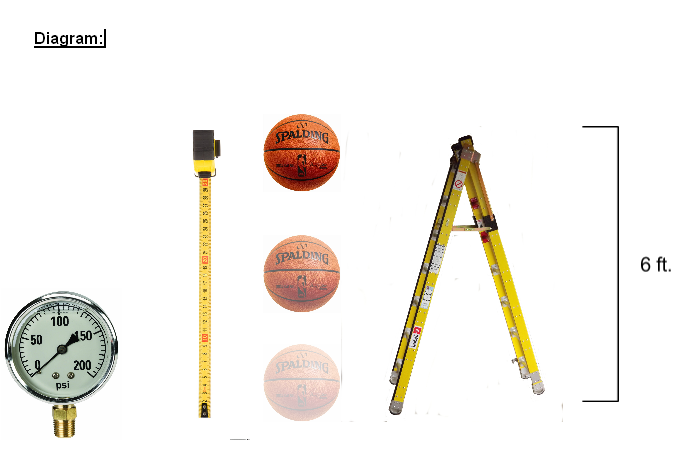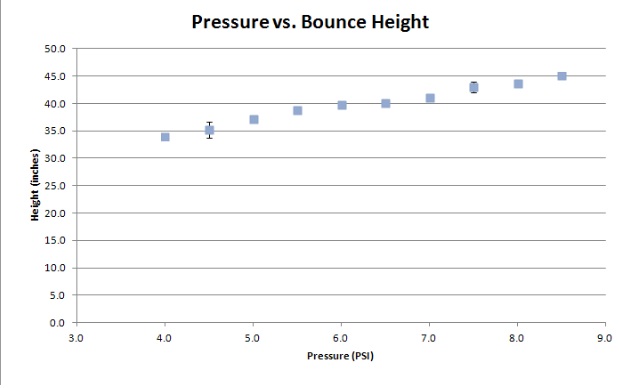Pressure vs. Bounce Height
Troy Woodward James Chung Jonathon Chung Justin Hockett
Table of contents
Background Problem Hypothesis Bibliography Data Table Graph Conclusion Return to Research
Introduction
Background: Basketball is a game played by
two teams with a ball and the objective is to put the ball through one of two
hoops placed at opposite sides of the court(Basketball Basics). Basketball was
first invented in 1891 by James Naismith, and was played with peach baskets for
hoops and a soccer ball. The NBA was founded in 1949 but the modern style of
play wasn’t adopted until 1976 (Sports Know How). The basketball itself is a sphere
with a circumference of 29.5 inches and consists of an inner rubber bladder
that is covered with either leather, rubber, or a synthetic substance. The
purpose of a basketball is to be bounced, or “dribbled”, down a court and
thrown into a hoop, so the ball has to be able to bounce fairly easily and have
grip to be able to be thrown accurately. If the ball isn’t pumped to the
required psi then its performance won’t be up to standards, either bouncing too
little, or too much. Elasticity is a term used for the
property of a solid object to return to its original shape and size after the forces
that deformed it are no longer acting on it (Elert). Things like springs,
rubber balls, and rubber bands all have elasticity because they all revert back
to their original shape after forces deform them. This means that for a ball if
it is bounced then the force isn’t gone after it’s impact with the ground, its
elasticity allows it to bounce. As a ball is dropped its velocity is downward
with respect to gravity. As it collides with the ground the ball is compressed
due to the impact, and as it snaps back to its original shape it pushes
against the ground (Normani). If the force of the ball pushing against the
ground is greater than the ball’s weight, then it will bounce back up to a
certain height, always lower than the original if dropped, depending on how
much force the push back gave it (Normani). It will repeat this process as
gravity pulls it back towards the ground until the weight of the ball is too
much for it to bounce back up. Statement of the problem: The
purpose of this investigation is to determine the effect psi has on the
bounce/rebound height of a basketball. Hypothesis: We believe that
the bounce height of the basketball will increase as the psi inside the ball
increases. This will most likely occur because the increase in psi will
increase the amount of air molecules in the ball, which cause it to become more
rigid, and thus allow it to “snap” back with more force after it hits the
ground. The controlled variables include, but are not limited to: drop
height of 6 feet, basketball, temperature, and ground surface. Working
Setup/Data Method: In order to collect the data for our experiment we will first
gather all the materials necessary. We will then put up the ladder and
climb up to a height of 6 feet. Next we will drop the ball and measure
the maximum height after the first bounce by using a slow motion camera.
Using the camera will allow us to see, with relative certainty, when the
ball has stopped its upward ascent and will allow us to find it maximum height
after one bounce. We will repeat this process starting at a psi of 5 lbs
per square inch and increasing the pressure each by 0.5 psi. We will test
the ball at 10 different pressures with three trials each. After 3 trials
of the first pressure, we will then inflate the basketball by 0.5 psi and use
the pressure gauge to check. We will do this every time before we test
the next pressure. Continue the process until all data has been
collected. Materials: Basketball, psi gauge, ball pump, tape measure, ladder, camera. Diagram: Results Data Table: Psi
(lbs per square In) Bounce
Height Trial 1 (Inches) Bounce
Height Trial 2 (Inches) Bounce
Height Trial 3 (Inches) Bounce
Height Average (Inches) 4 35 ±
0.5 34 ±
0.5 35 ±
0.5 34.3 ±
0.5 4.5 35 ±
1.5 37 ±1.5 38 ±
1.5 36.7 ±
1.5 5 37 ±
0.5 38 ±
0.5 38 ±
0.5 37.7 ±
0.5 5.5 39 ±
0.5 40 ±
0.5 39 ±
0.5 39.3 ±
0.5 6 40 ±
0.5 40 ±
0.5 41 ±
0.5 40.3 ±
0.5 6.5 41 ±
0.5 40 ±
0.5 41 ±
0.5 40.7 ±
0.5 7 41 ± 0.5 42 ± 0.5 42 ± 0.5 41.7 ± 0.5 7.5 45 ±
1.0 44 ±
1.0 43 ±
1.0 44 ±
1.0 8 44 ±
0.5 44 ±
0.5 45 ±
0.5 44.3 ±
0.5 8.5 45 ±
0.5 46 ±
0.5 46 ±
0.5 45.7 ±
0.5 Summary of results: After collecting all the data,
we noticed that as the psi inside the basketball increased, the bounce height
of the ball increased at a near-constant rate. Furthermore, the results agreed
with our hypothesis. Graph: Conclusion The results showed that the
pressure did affect the bounce of the basketball when it was dropped from six
feet. As the psi increased, the ball bounced higher each time giving a total
difference of 11 inches from the first trial to the last trial. Our hypothesis
predicted that the increase in psi would give a higher bounce and it was
correct. For the range of the pressures that we tested we only had growth in
bounce height. This meant that the ball was still being compressed each time
and rebounding with greater force each time. The increase in psi increased the
bounce height because it allowed the ball to become more rigid as the psi
increased. This caused the ball to snap back to its original shape with more
force once it hit the ground because the added pressure resisted the ball’s
change in shape more each time pressure was added. This trend would be expected
to continue until a certain point where the pressure would be too great for the
ball to bounce as high as the previous trial because it would be too rigid to
compress as much. Main sources of error were
probably in our data collection. We used an iPhone with a slow motion camera to
record the bounce and a measuring tape on the wall and we just eyeballed where
it bounced back up to from looking at the film. Our measurements could have
been more precise. There was also slight error in the pressure gauge because it
couldn’t have been perfectly precise for each trial. There was also a minute
leak of air as the needle was removed from the ball after inflation, but there
isn’t a great way to fix that unless we improved upon the manufacturer’s seal.
Another possible error in the data collection was that the drop height
wasn’t always exactly constant. While the general height that the ball
was dropped at was six feet, it was impossible for us to drop the ball at the
exact same height each time. To improve on our procedure we
would use a higher drop height to emphasize change in the data and have a
camera mounted sturdily with slow motion to give us more precise measurements.
We would also test more pressure variations by doing more trials starting at
zero and going beyond the ball’s maximum psi. We would have done this but we
didn’t have an old ball to use. It would have been much better to go beyond the
ball’s maximum psi to see if there was a point where the increase in bounce
height stopped, and started to decrease. This would be expected because
eventually it would become much too rigid to have the same bounce as before. Related Websites Information on the origin
of the basketball.
http://physics.info/elasticity/ This is about
the physics of elasticity and how this applies to our project.
http://www.real-world-physics-problems.com/bouncing-ball-physics.html This is about the physics
of a ball bouncing and how it works.
https://www.breakthroughbasketball.com/basics/basics.html
About the rules
of the game of basketball.
http://www.sportsknowhow.com/basketball/history/basketball-history.shtml This is about
the history of the sport of basketball. Bibliography: "Basketball (ball)." - Wikipedia, the Free
Encyclopedia. N.p., n.d. Web. 13 Jan. 2015. <http://en.m.wikipedia.org/wiki/Basketball_(ball)>. Elert, Glen. "Elasticity." - The Physics
Hypertextbook. N.p., n.d. Web. 13 Jan. 2015.
<http://physics.info/elasticity/>. Normani, Franco. "Bouncing Ball Physics." Real World
Physics Problems. N.p., n.d. Web. 12 Jan. 2015. <http://www.real-world-physics-problems.com/bouncing-ball-physics.html>. "Site Search." Basketball Basics. N.p., n.d. Web.
11 Jan. 2015. <https://www.breakthroughbasketball.com/basics/basics.html>. "SportsKnowHow.com - HISTORY OF BASKETBALL - Page 1 of
4." History of Basketball. N.p., n.d. Web. 11 Jan. 2015.
<http://www.sportsknowhow.com/basketball/history/basketball-history.shtml>. DO NOT CLICK: YOU HAVE BEEN WARNED!

